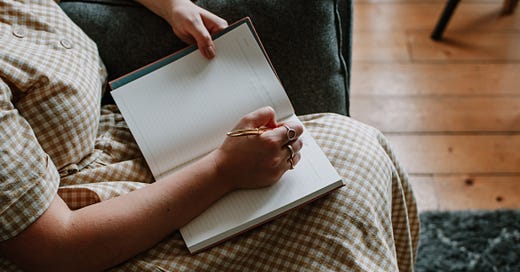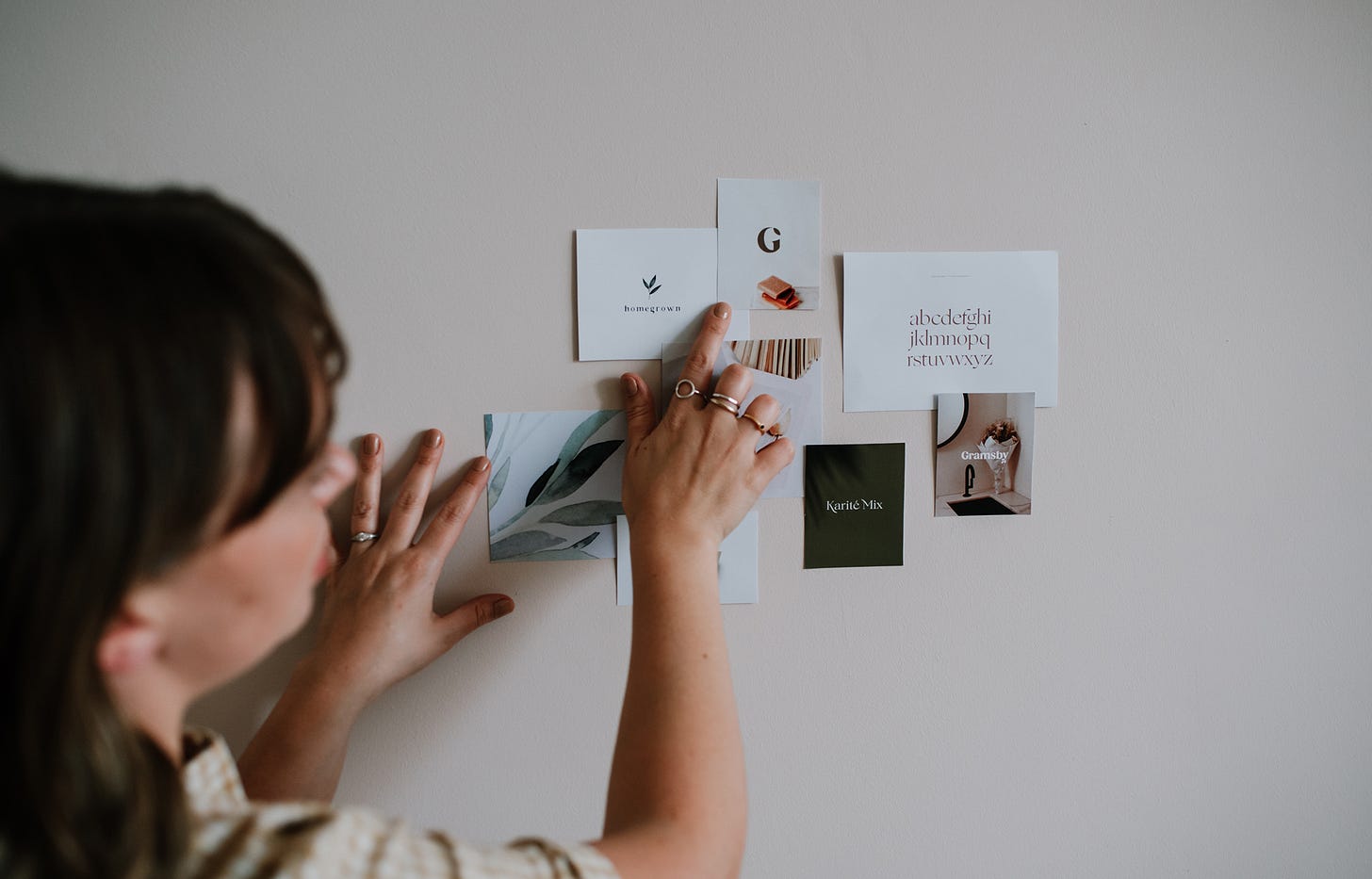Returning to creative rest
This Creative Life #05: on slow rhythms, soft rituals + creating from a place of steadiness
If I were to map out my energy on one of those balance charts — you know the ones, where you aim for a neat circle around health, family, love, money, work, friendship — the highs and lows would be obvious. In some ways, I’m ebbing; in others, I’m flowing. And while I know that’s completely natural, I’ve found myself searching for ways to ease the overwhelm.
Last year, I wrote a piece about creative rest, published on
. It reflected on my experiences of chronic fatigue and creative burnout, themes that have resurfaced in my life and work lately.Today, I’m revisiting and repurposing this essay. Because it’s not just about rest. It’s about the slow unravelling of a life lived without boundaries and beyond capacity. About honouring our energy and learning to create from a place of wholeness.
I believe rest is the soil our creative work grows from. And this piece is an invitation to tend to ourselves, to trust that not everything has to be earned through effort. It’s also a reminder to me, in a season of tiredness, to return to centre.
A call for creative rest
by Sarah Robertson
It was a cold Sunday evening in late 2018 when my body finally said "no."
Crushed by exhaustion, I entered a year-long cycle of rheumatology and physiotherapy appointments, followed by MRI scans and, still, no clear diagnosis. “It may be fibromyalgia,” one consultant offered, “but you don’t tick enough boxes.”
With more questions than answers, I set out to understand what had brought me to the point of physical burnout. To make sense of the symptoms that required pain management and constant referrals.
Looking back, the signs were there. I was going through secondary infertility and recurrent miscarriage, all while balancing my role as a mother to my firstborn and managing a small design studio, and pushing beyond my capacity had put immense stress and strain on my nervous system. Something had to give.
Though change didn’t happen overnight, my recovery depended on reshaping not just my habits, but my whole way of being.
Coming back to the body
That realisation led me to somatic coaching — a practice rooted in the Greek word soma, meaning the living body. Somatics centres on awareness, movement and sensation to support emotional and physical wellbeing.
Through online sessions, I began learning how to get "into" my body, support my natural rhythm and understand the subtle cues I was being given. Over time, I released the physical tension caused by testing, treatment and trauma, and I could see how my sensory perceptions and emotional reactions had contributed to my patterns and symptoms.
It was a powerful exercise in learning my bandwidth, knowing my limits and trusting my body. For the first time, I had tools to notice — and sometimes prevent — the onset of fatigue. It brought a kind of relief that no prescription had offered. At its core, this was about coming home to myself and learning how to make better choices from a place of care.
Why we need creative rest
Another turning point came when my coach,
, introduced me to the concept of the seven types of rest, drawn from the work of Sandra Dalton-Smith. In her book Sacred Rest and her TEDx Talk, she shares how true recovery requires more than sleep — we also need to restore our physical, mental, sensory, emotional, social, spiritual and creative energy. Each type of rest matters. But for me, creative rest became a lifeline, a way to reignite a lost sense of playfulness and possibility.Dalton-Smith describes creative rest as something that “reawakens the childlike awe and wonder in each of us.” I needed that deeply. I found that the grief and guilt I was carrying began to dissipate when I was in nature, especially near water. Whether by the coast, a river or quiet stream, water has a way of grounding me in the present and opening me to something greater than myself.
In Blue Mind, Wallace J Nichols explores the science behind this, revealing the profound impact water can have on our creativity, even in everyday moments like taking a shower, where ideas often flow with ease.
Letting the mind wander
Creative rest is also about giving ourselves the freedom to daydream, to make space for curiosity and exploration without the pressure of productivity. As a designer, daydreaming is essential to solving problems and making decisions. It’s a tonic for those who regularly need to tap into their ingenuity and resources.
Music is another fuel for the imagination, and I love the energy of live performances and festivals. I also enjoy making playlists, little soundtracks to my days, and a recently curated one is The Writing Life if you’d like to tune in.
Many of us are busy so the notion of rest can seem out of reach. In a world wired for doing, we’re less familiar with being. But as Dalton-Smith suggests, the remedy lies in identifying and nurturing our own rest needs and making them a part of the everyday. Tiny steps, I’ve found, can lead to great changes, both in emotional recovery and physical restoration. Incorporating rest is not necessarily about making drastic changes but gently nudging ourselves forward.
Creative rest can also look like immersing ourselves in the arts by visiting galleries and museums, enjoying urban photography or street art and finding pockets of nature within the city such as public parks or community gardens. It can even take the form of crafting moodboards and colour palettes, tasks that occasionally fill my working day, while journaling serves as a go-to activity for untangling ideas.
Making space for creative rest
As Julia Cameron observes in The Artist's Way, creative recovery involves engaging in things that rejuvenate our spirit. There’s a sense of mental renewal because I’m not just disconnecting from daily stresses, but reconnecting with my inner self and with my clients and projects, too.
And let’s not forget — this is essential to sustaining our creative minds. We’re worth the time it takes to craft, doodle, paint or simply pause to appreciate. Because it’s not just about making things, it’s about honouring the act of living itself.
That goes for the spaces we inhabit, too. Some of us are inspired by chaos, others come from the tidy desk, tidy mind school of thought, and my desks at home and in my studio have become my inspiration stations, housing my favourite crystals, plants and stationery, and a medley of books to help kindle my imagination.
When the spark is hard to find
But what if inspiration isn’t striking? Sometimes, I just need to step away from my desk and into a different space — planning from the dining table, writing in the garden or people-watching at the local café.
In The Creative Act: A Way of Being,
explores the art of creative rejuvenation, emphasising the value of finding inspiration in simple moments. This might look like taking yourself on a colour walk through the woods or noticing how the light shifts through the trees at golden hour. You could rearrange your bookshelf, refresh your workspace or simply follow a creative impulse without needing it to be anything.If you’ve ever watched a child lost in play, you’ll know how naturally they inhabit a world without pressure or performance. They explore without needing a reason. And maybe that’s the heart of creative rest: making space not just to return to ourselves, but to remember what lights us up.
Thanks again to for first featuring this on The Hyphen.
Creative rest might not be a cure for chronic fatigue, but building calm moments into my daily and weekly rhythm always makes a noticeable difference. In this season of life and work, I’ve had to become more intentional about rest, perhaps because I’m still buzzing from a winter of busyness.
I’ve said before that it’s taken me time to slow down. And honestly? I think I repeat it as a reminder to myself — to keep nurturing rather than neglecting. Rest doesn’t come as naturally as it once did and that’s something I’m learning to sit with. But I’ve become better at noticing and gentler in my response. There’s far less pushing now than there was in a past life.
The most reliable way I’ve found to counter everyday stresses — which, more than anything, triggers my fatigue — is to step outside and find solace in nature. And when I feel bone tired, I return to the small comforts of home: lighting a candle, playing with tarot, writing in my journal.
When I feel creatively depleted, I look for whatever brings a flicker of joy or hope. Lately, my mind’s wandered back to the calligraphy and lettering classes I once took, and just yesterday I found myself searching for colour theory courses and letterpress workshops. What can I do for pure play?
With little ones, carving out space for solo creative trips can be a stretch. But it’s something I want to reclaim. Because these pauses don’t just soothe the edges of tiredness, they remind me why I love this creative life in the first place.
Creative rest looks different for everyone. The key is noticing what lights you up. What does it look like for you?









Finally got the chance to read this (at the perfect time) and I just wanted to say thank you for sharing this piece. It's can be such a challenge trying to return to yourself and your creativity, especially in the midst of the frustration of health challenges and feeling completely drained. I recently bought The Artists Way and I've just started The Creative Act. I'm so incredibly grateful for the words you've written Sarah! ❤️
Sarah this is gorgeous and I relate whole-heartedly. When I’m able, my rejuvenation is in the water. In the quieter moments it’s at home with tea and crochet. This is just so important to remember 🙏💕